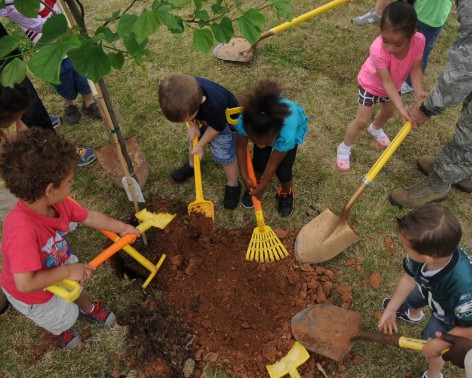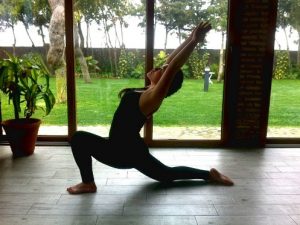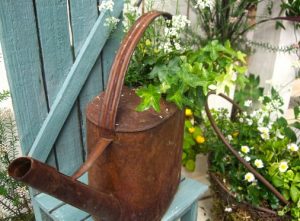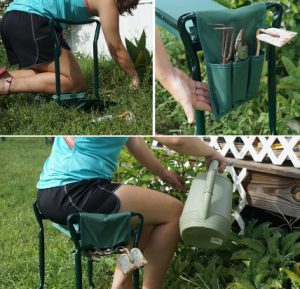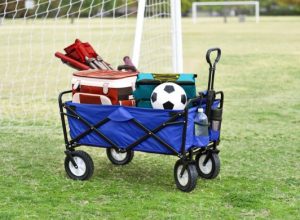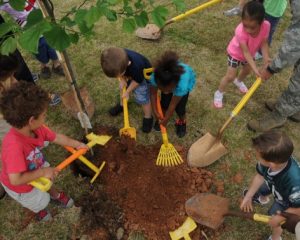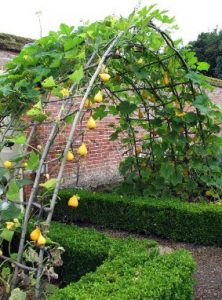Summer may seem like it’s an unending battle between the weeds that are in your garden and you. That battle might quickly turn into a fight between back pain that is result from your yard work and you. Gardening might feel slow-paced and peaceful, however it gives your body quite the workout – particularly if you have been struggling with chronic pain.
If you suffer from back pain the day after working in your garden it frequently can be due to your increased activity level, without preparing for it. Also, there are quite a few gardening activities that end up being done that involve a lot of lifting and twisting, repetitive movements or carried out for long periods of time and in undesirable positions, all of which may result in acute lower back pain occurring.
Research has shown that back pain currently affects more than fifty percent of adults who are over 40 years old, with the most common causes being mowing the lawn and gardening. Does that mean you have to give up the joys of your fresh-picked flower bouquets and homegrown tomatoes? Of course not. What you need to do instead is to take a smart approach to your gardening and use all of the tools and tricks that are available to assist you. The following are some of the best tips to prevent and reduce back pain that often comes with gardening.
Gardening Tips To Help With Back Pain
The following are several gardening tips that can help you garden while still being fairly gentle with your back.
1. Begin with prevention
Flexibility and strong core muscles are the keys to preventing injuries that might occur while you are gardening, like pulled leg muscles, strained shoulders or lower back pain. Leading a sedentary lifestyle, which includes sitting for long time periods, can weak your quadriceps and core muscles.
Some great exercises for gardeners include brisk walking, which helps to get your muscles warmed up and heart pumping, and yoga, with its focus on stretching exercises to increase your flexibility.
2. Set achievable goals
All of us have been in the position where you have a weekend that is completely free where you are planning to turn your soil and get your spring garden planted by Sunday. No matter what. However, don’t fall into that trap. What you should do instead, is set more modest goals for each day and then monitor your progress and how you are feeling every hour.
3. Warm up and stretch
If you exercise on a regular basis, warm-up and stretching prior to starting to garden are very smart precautions for you to take. However, if you don’t exercise on a regular basis, then stretching is absolutely necessary in order to keep your back protected.
Try doing some stretching exercises and taking a brisk five-minute walk. The back flexion exercise is a fairly gentle stretch, where you lie down with your back on the floor, and then pull both of your knees to your chest as you are moving your head forward.
Speak with your doctor or other health care provider if you have any back pain to find the best stretches to do.
4. Pay attention to your technique whenever you are lifting and bending
Chiropractors, physical therapists and other experts will say that when you are reaching and bending at your waist is when you are most vulnerable to getting injured. It is very easy to end up lifting heavy bushes, pots and full water cans the wrong way and hurting your back.
Make sure to use the correct techniques for bending and lifting to reduce the impact that gardening has on your body:
- To lift properly, starting by squatting instead of bending at the waist. Use both of your hands to hold onto to objects,and keep them close to your body, and as you lift straighten your legs slowly.
- Whenever you are kneeling, be aware of your position. Try to kneel with one of your knees up and the other one on the ground. To alleviate pressure, switch knees as necessary.
- Cut anything that is heavy in half, like a bag of compost.
- Don’t carry around full watering cans in both hands. Either carry one of them at a time or fill them half full. A couple of extra minutes hauling them can save you from all kinds of back problems later on.
- Avoid any reaching or sudden twisting motions and instead keep all of your movements smooth.
- To keep lifting to a minimum,use a dolly, wagon or other aid for carrying heavy objects from one place to the next. Large watering cans should only be filled half full, and think about using other watering options,like automated irrigation systems or soaker hoses.
- Depending on what your back problems are, it might be best to have others do some tasks that involve twisting and heavy lifting.
5. Take breaks
Remember that Rome wasn’t all built in one day. You can only work on your garden as much as you can do safely without hurting yourself, unless you have some people to help you. Slow down and fully enjoy your gardening, listen to the birds and smell the roses.
Take a 5 minute break every hour to sit down, stretch, and drink water or another beverage to replenish your fluids that you have lost due to exertion. You can easily make up for the time that you rest for 5 minutes with your increased productivity during the rest of the 55 minutes in the hour. Put some chairs next to your garden in the shade as a reminder to take a break and relax.
6. Switch tasks
Quite often back pain is the result of doing monotonous work. Changing your body posture on a regular basis can help to prevent back pain while you are gardening. To avoid one set of muscles getting over-stressed, alternate doing different tasks.
For instance, if you have been weeding for 30 minutes on your knees, have your next activity be one where you are standing. Tending to your hanging baskets or pruning taller shrubs can give your back and leg muscles a break.
Only work bent over for a couple of minutes at one time, before moving on to pulling, bending, squatting or digging to keep yourself from being in a bad gardening posture for a long period of time that can cause pulled muscles or more serious injuries.
7. Get support from chairs and kneelers
Depending on your flexibility and level of pain, getting up and down from the ground can be quite pain or even nearly impossible. Heavy-duty kneelers, particularly those that have padded, raised handles for helping you get up and down, lets you use the strength in your arms. Usually kneelers have a well-cushioned base that helps to reduce the amount of impact and stress on your back and knees. Many kneels will convert into a low chair as well.
8. Use knee pads as added cushioning
If it is more comfortable for you to kneel at ground level then moveable or wearable knee pads can be a good option. Multiple kinds of foam are frequently used to maximize the amount of cushioning. Always kneel while weeding, instead of bending at your waist while standing. Also make sure your back is kept straight.
9. Use long-handled and telescoping tools to help protect your back from getting injured
Use long-handled tools so that you can avoid squatting, bending or kneeling. Whether you are watering, cultivating or weeding, you can stay upright and also work while sitting when those tasks that done with tools that have 3- or 4-foot long handles.
Some of the long-handled tools that are available include trowels, bulb planters, weed pullers, grass sheers, edgers, hoes, cultivators, shovels and rakes. Telescoping tools can be particularly useful whenever you have tasks that need to be done in both raised beds and at ground level. With just a basic twists, the tools may be shorted to around 20 inches or even less from their completely extended length.
10. Use garden carts and wheelbarrows
Hedge plants that have large root bales, heavy flower planters and other objects within the garden can be especially hard on your back. When bearing a heavy load, your back is compressed, which means that your intervertebral discs and spine are pressed together. You want to avoid this as much as you can. The best thing to do use use equipment that has rollers. Use garden carts and wheelbarrows. They make carrying heavy objects easier if you have a hard time bending your knees or have back pain.
11. Garden Scooters Avoid Twisting
When you consider all of the movement that you’ll be doing in the garden, you’ll want to avoid the stretching and the twisting that will put additional strain on your back and joints. To help reduce this, consider using wheeled scooters. These come in a variety of sizes so you can easily find one to fit your garden space. Many larger scooters also h ave a basket to help you carry things.
12. Other Important Gardening Tools
- Vertical raised-beds or elevated are ideal to save your back. They are able to be built in a variety of heights so you’re sure to find the ideal height for your specific needs. Ideal for lower or upper back pain as well as knee pain.
- Stools and benches are another great alternative for helping to reduce kneeling and stretching. Perfect for planting and weeding they will reduce the time required for squatting down to garden.
- Ratchets are perfect for pruning jobs. Choose lightweight ratchet tools that will give more pressure on branches and limbs with minimal effort from you.
- Half-Height Wellies are perfect. If you’re working in wet or muddy environments you’ll want to have waterproof shoes. Full-length wellies may be too restrictive in small sized spaces. I suggest half-height boots to help you allow more movement in your ankles. If you can easily flex and bend your ankles you’ll be more likely to bend properly and ease back pain.
- Arch supports or insoles will give you even more stamina. You can choose customized orthotics to ensure that you’re not going to be putting undue stress on your back. If you’re going to be working for an extended period of time in your garden you’ll want to choose insoles that offer you plenty of cushioning and support. This will greatly relieve the impact that the ground surface has on your muscles.
- Ergonomic grass trimmers or weed eaters. Choose a weed eater that has a strap to wear around your shoulder. This means you won’t be putting added stress on your back. There are many top-rated weed eaters that will offer you a variety of benefits. Consider whether or not you’re going to have a cord to drag along with you as well.
- Retractable garden hoses keep you from having to stoop over and wind up a hose. They’re easy to use and when you’re done they are very easy to get wound up and put away so you won’t be tripping over them. Lighter weight than the average garden hose, you’ll save a lot of wear and tear on your back when you choose these.
13. Pace Yourself
Take your time and do it slowly. Pace yourself and listen to your body. If you’re getting sore or tired, stop. You can work more on your garden project later. Pain means that you need to stop and modify how you’re working on your garden.
14. When Your Finished
Just because you’re finished doesn’t mean you should flop down on that couch. Instead, take the time to do a “cool down” gardening is also a workout so those muscles need a cool down period. Yard work is just like any other exercise. Many people make this mistake.
Take a short walk around your garden and stretch those muscles out. You’ll feel better the next day if you just take the time to do this each and every time that you garden. You may even wish to soak in a hot bath to reduce sore muscles in the morning. You can add in some bath salts if you wish to ease the aches and pains. If your pain is due to a muscle injury, change how you garden to avoid this in the future.
15. Relieve Aches And Pains With Ice
If you do happen to overdo it, don’t be afraid to use an ice pack on your sore muscles for about 15 minutes at a time. This will help to reduce inflammation and soreness.
16. Hire Help Or Ask Friends Or Family To Help
If you encounter a task that you simply can’t do, don’t be afraid to hire help or ask friends or family to assist you. Many times they will be happy to help you and you can offer them produce as payment if you’re doing a vegetable garden. It’s amazing how much easier it is if you have an extra pair of hands.
17. Design Your Garden For Comfort
Keep in mind that you want to be comfortable. Redesign your garden if need be to include the following:
- Hanging Baskets
- Barrels as planters
- Window boxes
- Planters on tables
- Raised box beds
- Climbing plants
If you can raise the flower beds up to two or three feet high you’ll find that there are plenty more options to reduce back strain. You can sit on a stool or bench when you’re weeding or harvesting and it will greatly reduce any strain on your back. This is also ideal if you’re wheel chair bound. You can also combine beds with trellises for climbing vegetables like beans and peas.
If you want similar benefits you can also lower hanging plants so that you don’t have to stretch too high to reach them. Use walls and fences to include vertical gardening in your garden. The easier planters are to access the easier it is to garden. A balcony also offers a myriad of benefits to the gardener.
18. Consider A Potting Bench Or A Garden Bench
If you concentrate on plants that grow well in containers, you’re going to find that your gardening is far easier. Additionally, you can also use large sized containers to ensure that you can readily access your garden. Remember to use deep containers so that the roots have plenty of room to grow. Wheeled plant caddies are also an idea to help lift plants up and reduce the strain on your back if you need to move them around.
Potters benches or garden benches are also ideal for holding containers so that they’re at the right height. This helps to reduce bending and kneeling.
Benefits Of Gardening On Back Pain
If you’re suffering from back pain you already know that movement can help to reduce the pain. Keep your joints in motion and you’re far less likely to have back pain. Each case is different so be sure to check with your doctor or your physical therapist to ensure that you can gain more motion by gardening. Remember to follow correct posture and movement when gardening to reduce back pain.
- Exercise like gardening can greatly aid in recovery from a back injury. This can also help to release endorphins so that you’re in less pain.
- There is great healing to be had in gardening. It can encourage you to move and in turn, help to retain the flexibility in your back.
- Your muscles will be stronger and you’ll be able to get around better if you work on movement.
Conclusion
Following these tips will go far in helping you to do your own yard work and gardening. Always follow ergonomic rules and the doctors suggestions for best results.
